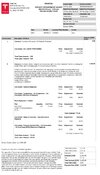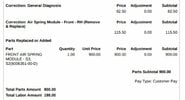My 2015 P85DL is losing air in the suspension slowly overnight. It seems to be the rear right that drops and sometimes both rear and front right are deflated while the left side is still inflated, and other times it's both sides in the rear that seems deflated. As such it is not that big a deal as the compressor quickly fills up the system when starting the car. Sometimes while driving I can hear a small burst of air being pumped by the compressor, but not every time I'm out driving. I can't really say for sure, but the deflation also seems to have a correlation with the ambient temperature.
So I had the car at the local SC to do a diagnosis and they came back the following message: 'we can not do a full diagnosis before we have replaced the compressor, the solenoid block and the RH rear air spring. This may solve the problem, but we can't be sure before we have replaced those parts - and it will cost you around $3,500'
So my take on this is that there is no way that all three parts are faulty, they just don't know where the leak is and have wasted my money diagnosing without a result. The compressor sounds healthy and it does not work hard at any point. Filling the system in the morning it works just like it would from low to high, no longer.
So I was thinking if the solenoid block or the rear air spring would be the best bet to start with? Does anybody have any experience that can help me?
So I had the car at the local SC to do a diagnosis and they came back the following message: 'we can not do a full diagnosis before we have replaced the compressor, the solenoid block and the RH rear air spring. This may solve the problem, but we can't be sure before we have replaced those parts - and it will cost you around $3,500'
So my take on this is that there is no way that all three parts are faulty, they just don't know where the leak is and have wasted my money diagnosing without a result. The compressor sounds healthy and it does not work hard at any point. Filling the system in the morning it works just like it would from low to high, no longer.
So I was thinking if the solenoid block or the rear air spring would be the best bet to start with? Does anybody have any experience that can help me?




